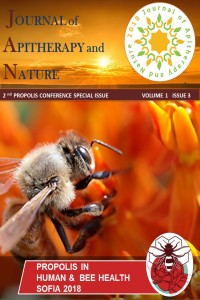Abstract
Propolis is a complex mixture
of resinous material collected by bees from tree branches, bushes and leaves
and transported to the beehive, where secretions, wax and pollen are added.
Honeybees use this mixture with mechanical and biological purposes, to repair the
hive, moisture management and to prevent the entrance of intruders1.
The chemical composition of propolis depends on the botanical source around the
apiary but also on the geographical and climatic conditions, with bees
preferring specific resin sources. In temperate regions, such as Portugal, the
main botanical sources of the resin are poplar, gum rockrose, oak, willow and
acacia2.
This research outlines the
study of how the origin of honeybees can influence the quality of propolis,
comparing its physicochemical parameters. Honeybees used on this assay came
from two distinct regions of Portugal, from the south (Vila-do-Bispo) and north
(Bragança). Propolis production was carried out in two apiaries geographically
distinct, Bragança and Vila-do-Bispo and honeybees from the two regions were
established in both sites.
apiaries, observing a greater content on wax and ashes in the apiary samples
from the south. As regards to the phenolic composition, the content of total
phenol and flavonoids was higher on the samples from the north side. In respect
to the impact of the geographical origin of honeybees, it is found that the
physical parameters and the phenolic characteristics are similar within the
same apiary and no significant differences were observed considering the origin
of honeybees.
Keywords
References
- 1. Bankova VS, De Castro SL, Marcucci MC (2000) Propolis: recent advances in chemistry and plant origin. Apidologie 31: 3-15.
- 2. Falcão SI, Tomás A, Vale N, Gomes P, Freire C, Vilas-Boas M (2013) Phenolic quantification and botanical origin of Portuguese propolis. Industrial Crops and Products 396: 887-897.
Abstract
References
- 1. Bankova VS, De Castro SL, Marcucci MC (2000) Propolis: recent advances in chemistry and plant origin. Apidologie 31: 3-15.
- 2. Falcão SI, Tomás A, Vale N, Gomes P, Freire C, Vilas-Boas M (2013) Phenolic quantification and botanical origin of Portuguese propolis. Industrial Crops and Products 396: 887-897.
Details
| Primary Language | English |
|---|---|
| Journal Section | Conference Paper |
| Authors | |
| Publication Date | December 8, 2018 |
| Published in Issue | Year 2018 Volume: 1 Issue: 3 - 2nd Propolis Conference Special Issue |
Cite
- Google Akademik (Google Scholar)
- idealonline
- Directory of Research Journal Indexing (DRJI)
- Asos İndeks

